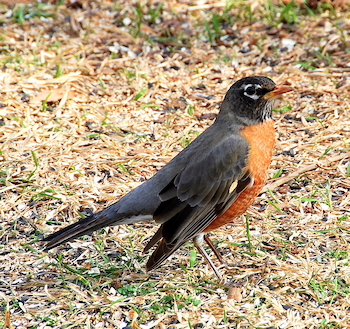
By Terry W. Johnson
As far as Georgia winters go, so far the winter of 2020–2021 actually was not been too bad. However, when you combine it with the current pandemic, it seemed long, cold and bleak, and left us longing for the first signs of spring. In my case, when I spotted the first crocus of the year I was filled with hope that spring was just around the corner.
On the other hand, many Americans believe that the appearance of a flock of robins descending on their backyard is a sure sign that winter's icy grip is weakening and spring is coming.
However, those of us who have lived most of our lives in the Peach state realize the appearance of robins is not a harbinger of spring at all. In truth, we are far more likely to see more robins in winter than during the spring, summer and fall combined.
It seems during the winter that vast flocks of migratory robins winter or pass through Georgia. Most of these are birds that breed north of the Peach State. In winter, robins travel in large flocks. The size of these flocks can be mind-boggling. In her book “Birds of the South,” Eloise Potter describes one flock roosting in pinewoods near New Hope, N.C., in the early 20th century estimated at several million robins. Closer to home, participants in the 1993 Christmas Bird Count at Piedmont National Wildlife Refuge and Rum Creek Wildlife Management Area watched a flock estimated at 2 million robins flying southward along the Ocmulgee River.
During the winter, the robin's diet is quite different than in spring and summer. If you have watched a robin hunting for food on your lawn, you know they employ a very distinctive technique to spot and capture worms. The bird will run a short distance, stop, cock its head at an angle and wait. Just when you think the bird is going to stand motionless forever, it will suddenly jab its bright yellow bill into the ground and pull out an earthworm.
Indeed, earthworms are an important part of the robin's diet. However, the birds also eat a number of other invertebrates, many of which are considered pests to farmers and backyard gardeners. For example, robins gobble down everything from cutworms to beetles. In fact, during spring and summer, invertebrates make up the main part of the bird's diet.
However, American robins will also eat fruit, such as cherries, blueberries, blackberries and strawberries. During the fall and winter, robins typically feast more on berries and fruits than worms and insects.
If you would like to put out the welcome mat for winter robins, there are a few simple things you can do. Begin by stocking your home landscape with native trees, shrubs and vines that retain their fruits and berries well into winter.
By all means, also avoid planting Chinese privet. Although robins relish privet berries, this plant is highly invasive and is choking out native plants throughout the state.
Native plants that produce fruits and berries eaten by wintering robins include flowering dogwood, hawthorn, wild blueberries (Vacciniums) such as deerberry and sparkleberry, American holly, American beautyberry, possumhaw and wax myrtle.
Sumac is also a favored winter food. I have seen flocks of robins descend on thickets of smooth sumac to dine on the plants’ red, hairy fruit. Although sumac is rarely planted in backyard settings, its colorful, persistent fruit and attractive foliage can be a great addition to the border of a large yard.
If you plant crabapple trees, select a variety such as Callaway crabapple whose small, hard fruits persist throughout the winter.
Although the cedar waxwing is named for its fondness for cedar berries, robins and other wildlife also eat the tree's small berries. Adding red cedars to your landscape is something you should consider.
Although the American robin is not considered a feeder bird such as cardinals and chickadees, they will come to feeders. However, although they will occasionally eat sunflower seeds, they are not big on consuming seeds.
To attract robins, you are better off serving up an eclectic menu of other foods ranging from suet and cooked spaghetti to peanut butter, pieces of nuts, doughnuts, cottage and American cheese, raisins, sliced fruit such as pears and apples, cornbread, currants, mealworms, earthworms, softened dry dog food and oranges.
Actually, robins are attracted to backyards more often with water than food. Regardless of the season, robins desperately need the water for both drinking and bathing. Here's a tip: Placing a feeder close to a birth bath will sometimes hasten robins’ acceptance of the food you’re offering.
If you are up to the challenge of trying to attract wintering robins to your yard, give some of these suggestions a try. Even if you fail to draw robins, a host of other wildlife neighbors will benefit from your efforts. Now that is what I call a win-win situation.
Terry W. Johnson is a retired DNR program manager and executive director of TERN, the Wildlife Conservation Section’s friends group. Check out past columns, his Backyard Wildlife Connection blog and his book “A Journey of Discovery: Monroe County Outdoors.” His columns are also featured at DNR’s blog, under the Conservation tab. Permission is required to reprint a column.